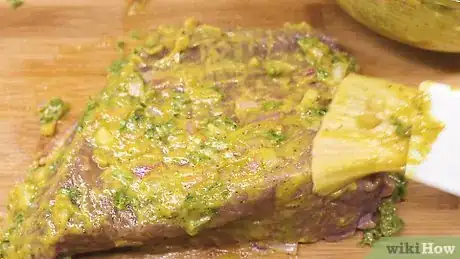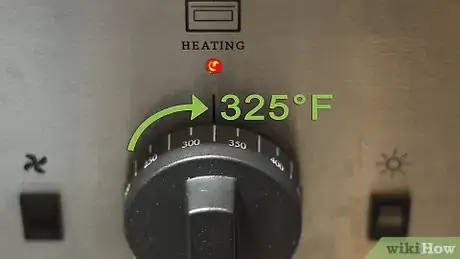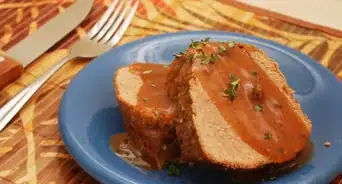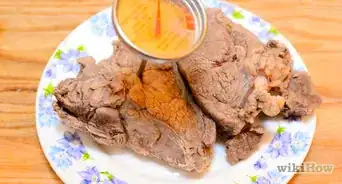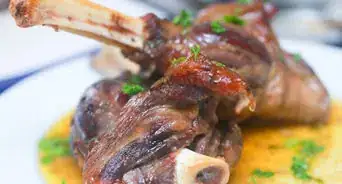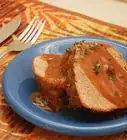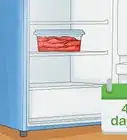This article was co-authored by wikiHow Staff. Our trained team of editors and researchers validate articles for accuracy and comprehensiveness. wikiHow's Content Management Team carefully monitors the work from our editorial staff to ensure that each article is backed by trusted research and meets our high quality standards.
There are 14 references cited in this article, which can be found at the bottom of the page.
The wikiHow Video Team also followed the article's instructions and verified that they work.
This article has been viewed 395,603 times.
Learn more...
A top round roast is a relatively lean section of meat taken from the inside of a cow’s hind leg. Despite being an inexpensive slice of meat, it is lean and very flavorful. Like its name suggests, roasting is the most common way to cook a top round roast, although it can be incorporated into stews. Once the meat reaches the desired temperature, it can be eaten right away or even used as deli-style roast beef.[1]
Ingredients
- 1 4 lb (1.8 kg) top round roast
- 0.3 oz (8.5 g) fresh parsley, chopped
- 1 US tbsp (15 mL) Dijon mustard
- 1 US tbsp (15 mL) olive oil
- 0.5 oz (14 g) unsalted butter
- 0.6 oz (17 g) salt
- 0.6 oz (17 g) pepper
- 1 shallot, minced
Steps
Seasoning the Roast
-
1Defrost the roast for up to 2 days in the refrigerator. This process can take a while due to the size of the roast, so get started ahead of time. Leave the roast in its original packaging while it thaws. You will have an easier time rubbing in the spices and cooking the meat after it is unfrozen.[2]
- If you’re in a hurry, you can try defrosting it in the microwave. Heat it at a low temperature until it is no longer frozen.
- Another way to speed up defrosting is to submerge the meat under cold water. Do this only if your roast is in a watertight container. Change the water out as it warms.
-
2Remove the roast from the refrigerator an hour ahead of time. The wait time brings the roast up to room temperature, causing it to cook more evenly. It won’t be out long enough to make bacteria an issue. You can vary the resting time between 30 minutes and 2 hours, depending on how much time you have available.[3]
- If you need to get the roast in the oven right away, that is fine. It will still cook well and taste good.
Advertisement -
3Mix all ingredients besides the roast in a separate bowl. Choose a mixing bowl and pour 1 US tbsp (15 mL) of olive oil into it. Add 1 US tbsp (15 mL) of Dijon mustard along with 0.5 oz (14 g) of butter, 0.3 oz (8.5 g) of chopped parsley, and a minced shallot. Sprinkle in about 0.6 oz (17 g) of both salt and pepper before stirring the ingredients into a paste.[4]
- You can mix the ingredients 24 hours in advance and put them in a bag with the roast. The meat will absorb more of the flavors while the salt draws out flavor from the meat.
- Experiment with your seasoning ingredients. For example, you can leave out the shallot and mustard. You can add other herbs and spices or make a balsamic glaze.
-
4Rub the entire surface of the top round roast with the paste. If you have a basting brush, use it to easily coat the outer surface of your roast. A brush is helpful if your mixture is too liquid. You can also pour the paste onto the roast and try to spread it using a knife or other tool.[5]
- Dry rubs and pastes can usually be worked into the meat by hand. If you’re not shy about getting your hands dirty, you don’t need to reach for a brush.
Roasting the Meat
-
1Preheat your oven to 325 °F (163 °C). Turn on your oven and give it a few minutes to get up to the proper temperature. Once it is heated, begin cooking the roast as soon as you can. You may see recipes using wildly different temperatures, and cooking the beef at a different temperature is fine if you want to experiment.[6]
- Lower temperatures mean slower cooking, so adjust your timer accordingly.
- Instead of using an oven, you can cook roasts in a dutch oven. Start by searing the meat in oil, then add beef stock and other ingredients. Put the dutch oven in your oven for 2 to 3 hours.[7]
- Another option is a slow cooker. Sear the meat before adding all of your ingredients to the slow cooker. Cook for about 4 to 6 hours on high or 8 to 10 hours on low.
-
2Place the roast in a roasting pan with the fat side up. Look for a layer of white fat on top of the red meat. This fatty end will usually appear rounded, while the opposite end is flatter and easier to rest against your roasting pan. Put the roast directly in the center of the pan.[8]
- You can also use a roasting rack. Fit it over a roasting pan or baking sheet, which will catch any dripping juices. If you use a slow cooker, don’t use a rack and instead cook the roast in the stock or other liquid you use.
- Another option is an oven bag. Seal the roast in the bag, then set it in a pan. Cut a few vents in the top.
-
3Multiply the weight of the roast by 21 minutes to find your cooking time. For example, a 4 lb (1.8 kg) top round roast takes about 84 minutes, or 1 ¼ hours. Larger roasts take longer to cook than smaller roasts. Similarly, a cold roast takes a little longer to cook than one at room temperature. Keep a close eye on your roast and test it with a meat thermometer if you aren’t sure it is done.[9]
- This is the average time to get your top round roast to medium rare. If you want it to be closer to well done, expect it take 30 to 35 minutes per pound. Roasts are best served medium rare, though.
- The average roasting time can also vary depending on your oven and the heat setting you use.
-
4Place the meat on a center rack in your oven. Position the meat, making sure it is in or over a pan that can catch any dripping juices. Close the door as soon as possible so the heat doesn’t escape. Then, set your timer as your roast begins to cook.
-
5Cook the roast in the oven for about 1 ¼ hours. Leave the roast in the oven for the amount of time you calculated earlier. Don’t open the oven door if you can help it, since doing so lets out the heat. If you think the roast may be done before the time is up, you should definitely check it to avoid overcooking.[10]
- You can start the roasting process at a higher temperature, then lower it after about 15 minutes. The high temperature can give the roast a nice, brown sear.
- Another option for browning is to heat olive oil in a pan, then sear the meat about 2 minutes per side. Put the roast in the oven when you are done.
-
6Use a thermometer to test the roast for a temperature of 135 °F (57 °C). Slide the thermometer’s tip into the center of the roast about 30 minutes before the cooking time is up. A temperature of 145 °F (63 °C) indicates a medium-rare roast, but you should remove the roast before it reaches this level of doneness.[11]
- A rare roast has a temperature between 125 to 130 °F (52 to 54 °C) when it is done.
- A medium roast reaches 160 °F (71 °C), while a well done roast reaches 170 °F (77 °C).
Serving the Meat
-
1Take the roast out of the oven before it finishes cooking. The meat gets hot enough that it continues cooking even after it is taken out of the oven. Plan on taking it out when it is 5 to 10 degrees below the desired internal temperature. This way, you get the exact doneness you want in your meat.[12]
- For example, if you want a medium-rare roast, remove the roast from the oven at the 135 °F (57 °C) mark.
-
2Tent the roast in foil and leave it on your counter. Move the pan to a safe location, such as a counter or your stovetop. To tent the roast, wrap a piece of aluminum foil over the top of the pan. The foil seals in the heat, allowing the roast to finish cooking to its final temperature. You do not have to remove your thermometer if you used it to test the meat earlier.[13]
- If you have the roast on a rack, take it off the rack and wrap it loosely in foil. Be careful not to burn your fingers!
-
3Allow the roast to rest for 15 minutes before carving. The additional waiting time is needed for the roast to cook up to the proper temperature. It also allows the juices to seal inside the meat. Instead of getting a bloody mess, you get a juicier piece of meat when you finally cut the roast.[14]
-
4Cut the meat into thick slices against the grain. Unwrap the roast and look closely at its surface. You should be able to see lines running across it, which are the meat’s muscle fibers. Instead of cutting along those lines, cut across them. The exact size of cuts doesn’t matter, but try slicing the beef as thinly as possible for lots of flavor with a minimal amount of chewing.[15]
- Use a sharp knife to ensure the meat cuts cleanly.
- Cutting the meat against the grain leads to delicious, tender pieces that are easier to chew.
-
5Store leftovers in airtight containers in the refrigerator or freezer. You can wrap the beef tightly in plastic or foil if you don’t have a container big enough. Also consider cutting the beef into multiple chunks in order to make storage easier. Keep it in the refrigerator if you plan on using it right away or make use of the freezer for long-term storage.[16]
- The beef should last up to 4 days in the refrigerator. If it looks slimy or smells bad, throw it away.
- Beef stored in the freezer will last up to 3 months. You can defrost it as needed before storing it in the refrigerator.
Community Q&A
-
QuestionDidn't you contradict yourself about the roast cooking time? Is it 20, 25, 30?
 Bob ReckerCommunity AnswerThe longer you roast per pound, the greater the degree of doneness. A 20 minute per pound roast will be on the rare side; 30 minutes will probably be well done. Two caveats: Unlike, say, a stew meat with high collagen, which will become more tender with longer cooking times, a roast such as this will become dried out and chewier. Also, just because you set your oven to 325°, for example, it doesn't mean your actual oven temperature is that. Get an oven thermometer, set the oven at the desired temperature, and see what the "real" temperature is. Then, adjust the setting on the dial until the interior oven temperature is exactly the one you want. Remember that setting and use it.
Bob ReckerCommunity AnswerThe longer you roast per pound, the greater the degree of doneness. A 20 minute per pound roast will be on the rare side; 30 minutes will probably be well done. Two caveats: Unlike, say, a stew meat with high collagen, which will become more tender with longer cooking times, a roast such as this will become dried out and chewier. Also, just because you set your oven to 325°, for example, it doesn't mean your actual oven temperature is that. Get an oven thermometer, set the oven at the desired temperature, and see what the "real" temperature is. Then, adjust the setting on the dial until the interior oven temperature is exactly the one you want. Remember that setting and use it. -
QuestionIf I prepare my roast this way, will it be tender?
 Bob ReckerCommunity AnswerIt should. The longer you cook it, the drier and chewier (or tougher) it will be. When the interior of the roast is 120°, remove it from the oven and let it rest covered. This will cause about a 5° internal temperature rise and redistribute the interior juices. This will give you about a medium-rare result, depending on the thickness of the meat.
Bob ReckerCommunity AnswerIt should. The longer you cook it, the drier and chewier (or tougher) it will be. When the interior of the roast is 120°, remove it from the oven and let it rest covered. This will cause about a 5° internal temperature rise and redistribute the interior juices. This will give you about a medium-rare result, depending on the thickness of the meat. -
QuestionI have no rosemary or allspice. Can l make this roast successfully without these two ingredients?
 Bob ReckerCommunity AnswerYou can substitute tarragon or thyme for rosemary. You can use equal amounts of cinnamon, clove, and nutmeg to substitute for the allspice.
Bob ReckerCommunity AnswerYou can substitute tarragon or thyme for rosemary. You can use equal amounts of cinnamon, clove, and nutmeg to substitute for the allspice.
Things You'll Need
- Roasting pan
- Mixing bowl
- Measuring spoons
- Oven
- Meat thermometer
- Aluminum foil
- Sharp knife
References
- ↑ https://www.thekitchn.com/whats-the-difference-between-top-round-roast-and-chuck-roast-242523
- ↑ http://www.recipetips.com/kitchen-tips/t--349/thawing-beef.asp
- ↑ https://www.bonappetit.com/story/room-temperature-meat-tempering
- ↑ https://thefeedfeed.com/girlcarnivore/herb-crusted-top-round-roast-beef
- ↑ http://www.recipetips.com/recipe-cards/t--3626/top-round-beef-roast.asp
- ↑ https://cooking.nytimes.com/recipes/1017348-the-best-roast-beef-for-sandwiches
- ↑ https://www.thekitchn.com/basic-recipe-template-weekend-95076
- ↑ https://www.allrecipes.com/recipe/94113/high-temperature-eye-of-round-roast/
- ↑ http://www.recipetips.com/kitchen-tips/t--906/beef-cooking-times.asp
- ↑ https://www.cookstr.com/Beef-Recipes/Straight-Up-Roast-Beef
- ↑ https://www.tasteofhome.com/recipes/herb-crusted-roast-beef/
- ↑ https://cooking.nytimes.com/recipes/1017348-the-best-roast-beef-for-sandwiches
- ↑ http://www.recipetips.com/kitchen-tips/t--372/roasting-beef.asp
- ↑ https://www.tasteofhome.com/recipes/herb-crusted-roast-beef/
- ↑ https://www.finecooking.com/article/how-to-cut-meat-against-the-grain
- ↑ http://www.stilltasty.com/fooditems/index/16498
About This Article
Before you cook a top round roast, bring the roast to room temperature, then season the meat with salt and pepper, plus seasonings like Dijon mustard, butter, parsley, and shallots. Place the meat in a roasting pan with the fat side up, then roast it in a 325°F oven. To find out how long to cook the roast, multiply the weight of the roast by 21. The result is your cooking time for a medium-rare roast, but you can add more time if you want your roast to be well-done. Take the roast out of the oven and allow it to rest for 15 minutes before you carve it. Keep reading to learn how to slice a roast!


